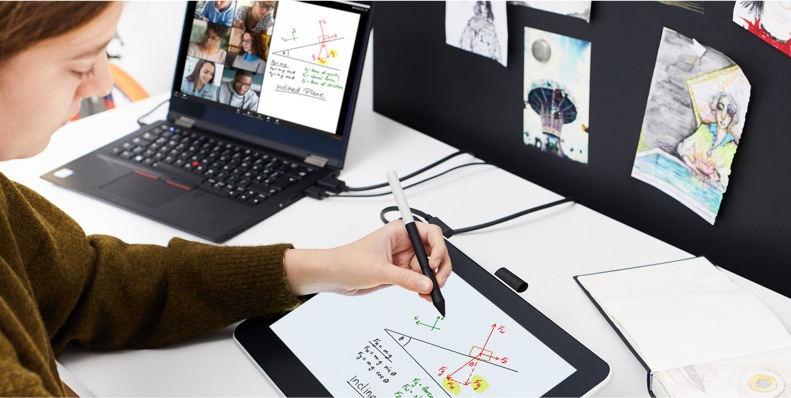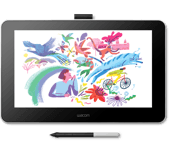Pen tablets
Sketch, draw and edit images with a responsive pad, a precise pen and see your creations appear on screen.


The creative possibilities of effective collaboration are endless. Our ideas are always better when shared and honed with others. Whether it’s tweaking strategies or developing initial thoughts about new projects, we’re able to be so much more creative in our approach when we do so together.
So, what does creative collaboration look like when remote working and isolation are compulsory? Does it become less effective? Not necessarily. Video calls and virtual brainstorm sessions can be just as good for developing ideas and refining projects, as these handy principles and tips show.
So, what does creative collaboration look like when remote working and isolation are compulsory? Does it become less effective? Not necessarily. Video calls and virtual brainstorm sessions can be just as good for developing ideas and refining projects, as these handy principles and tips show.

It can feel challenging setting up a large group video call. The good news is that services are designed to handle multiple callers and there are myriad techniques to ensure that everyone feels engaged and involved. For one, unlike on a standard call, the temptation to multitask is far less. After all, colleagues will be able to see each other reaching for their phone or looking across the room.
After getting everyone onto the call, make sure to say hello to each person in turn. Having already shared an agenda via email, it’s a smart move to encourage the use of chat tools within video conferencing to help share thoughts and ask questions, rather than interrupting someone’s flow while they’re talking.
This can also be effective when discussing a particular problem or item. Ask everyone on the call a question and, rather than having each of them give their response using their voice, get them to send their responses via chat during a quick, five minute break. That way, ideas can then be shared by the person chairing the meeting once they have been collated, before being discussed in a group.
The key is to make everyone on the call feel engaged and as if they have something to contribute. The power of body language to boost morale is vital here. A nod or a thumbs-up can be empowering. This makes the call and interaction more transparent and more human.
The best video conferencing software not only allows you to speak with colleagues face-to-face. It also lets you share and annotate your screen in real time. This can be particularly helpful when working through a presentation or new project. Make best use of Wacom’s cutting edge pen tablets and displays to circle or underline the parts of a document that you’re talking about. And encourage others to share their screens in turn so everyone can see what they’re talking about as they discuss it.
This can make video calls every bit as productive as a meeting in the office. Those on the call can see what’s being discussed in real time and delve into documents, presentations or on-screen notes as the meeting progresses, meaning solutions and ideas can be put forward as the conversation flows.
Similarly, shared documents can be worked on together while calls are underway, allowing everyone to put their thoughts and ideas in one place. This is then easily accessible to all after the meeting ends.

Brainstorming sessions can easily go off track in the office and are just as likely to do so in a remote working environment. The good news is that a few simple rules can help make them very useful. First off, be sure to make use of specific online brainstorming platforms that allow for easy visual collaboration.
Most importantly, one person should act as the moderator, running the session and focusing on keeping minutes to action afterwards. Before starting, this person should send around the topic to be discussed and set a time limit, ideally more than a day, for those taking part on the call to come up with ideas. These should be considered alone and not shared with the group before the call, so as to ensure everyone’s voice is heard.
During the call, set a time limit for each person to discuss their ideas. These can be added to a virtual whiteboard tool. A drawing tablet will make this process even easier and more natural. Once all the ideas are in, set a time limit for a discussion about them. Actions should then be shared using a group chat tool after the meeting, allowing everyone to understand the next steps and what they need to make them happen. The fact that people can then go away and work in isolation on their set tasks actually makes this approach better than in the office, where other work projects may serve as a distraction.
Recommended product

Wacom One 13
Draw, design and create directly on a high resolution screen with a precise pen.

Sketch, draw and edit images with a responsive pad, a precise pen and see your creations appear on screen.

Draw, design and create directly on a high resolution screen with a precise pen.


Wacom 的愿景是通过自然的界面技术汇聚人与科技。这项愿景让 Wacom 成长为交互式数位板、数位屏及数位触控笔的全球性制造商,以及数字签名保存与处理解决方案提供商。Wacom 直观输入设备所采用的技术已催生出全世界诸多一线数字艺术品、电影、特效、时尚及设计佳作,其界面技术同时为商业和家庭用户提供表达自我个性的利器。创办于 1983 年的 Wacom 公司是一家全球性公司,总部位于日本(东京证券交易所上市编号:6727),分公司及营销与销售代表处遍布世界各地 150 多个国家/地区。